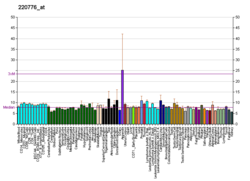Protein-coding gene in the species Homo sapiens
| KCNJ14 |
|---|
|
| Identifiers |
|---|
| Aliases | KCNJ14, IRK4, KIR2.4, potassium voltage-gated channel subfamily J member 14, potassium inwardly rectifying channel subfamily J member 14 |
|---|
| External IDs | OMIM: 603953; MGI: 2384820; HomoloGene: 27086; GeneCards: KCNJ14; OMA:KCNJ14 - orthologs |
|---|
| Gene location (Human) |
|---|
 | | Chr. | Chromosome 19 (human)[1] |
|---|
| | Band | 19q13.33 | Start | 48,455,574 bp[1] |
|---|
| End | 48,466,980 bp[1] |
|---|
|
| Gene location (Mouse) |
|---|
 | | Chr. | Chromosome 7 (mouse)[2] |
|---|
| | Band | 7|7 B3 | Start | 45,465,884 bp[2] |
|---|
| End | 45,474,206 bp[2] |
|---|
|
| RNA expression pattern |
|---|
| Bgee | | Human | Mouse (ortholog) |
|---|
| Top expressed in | - putamen
- stromal cell of endometrium
- gastrocnemius muscle
- skin of abdomen
- caudate nucleus
- skeletal muscle tissue
- prefrontal cortex
- bone marrow
- ganglionic eminence
- cerebellum
|
| | Top expressed in | - anterior horn of spinal cord
- eyelid
- olfactory cortex
- spinal ganglia
- lower eyelid
- amygdala
- upper eyelid
- trigeminal ganglion
- septum of telencephalon
- autonomic nervous system
|
| | More reference expression data |
|
|---|
| BioGPS |  | | More reference expression data |
|
|---|
|
| Gene ontology |
|---|
| Molecular function | - voltage-gated ion channel activity
- inward rectifier potassium channel activity
| | Cellular component | - integral component of membrane
- voltage-gated potassium channel complex
- neuronal cell body
- plasma membrane
- dendrite
- membrane
| | Biological process | - potassium ion transport
- regulation of ion transmembrane transport
- ion transport
- potassium ion import across plasma membrane
- cardiac conduction
| | Sources:Amigo / QuickGO |
|
| Orthologs |
|---|
| Species | Human | Mouse |
|---|
| Entrez | | |
|---|
| Ensembl | | |
|---|
| UniProt | | |
|---|
| RefSeq (mRNA) | | |
|---|
| RefSeq (protein) | | |
|---|
| Location (UCSC) | Chr 19: 48.46 – 48.47 Mb | Chr 7: 45.47 – 45.47 Mb |
|---|
| PubMed search | [3] | [4] |
|---|
|
| Wikidata |
| View/Edit Human | View/Edit Mouse |
|
Potassium inwardly-rectifying channel, subfamily J, member 14 (KCNJ14), also known as Kir2.4, is a human gene.[5]
Potassium channels are present in most mammalian cells, where they participate in a wide range of physiologic responses. The protein encoded by this gene is an integral membrane protein and inward-rectifier type potassium channel, and probably has a role in controlling the excitability of motor neurons. Two transcript variants encoding the same protein have been found for this gene.[5]
See also
References
- ^ a b c GRCh38: Ensembl release 89: ENSG00000182324 – Ensembl, May 2017
- ^ a b c GRCm38: Ensembl release 89: ENSMUSG00000058743 – Ensembl, May 2017
- ^ "Human PubMed Reference:". National Center for Biotechnology Information, U.S. National Library of Medicine.
- ^ "Mouse PubMed Reference:". National Center for Biotechnology Information, U.S. National Library of Medicine.
- ^ a b "Entrez Gene: KCNJ14 potassium inwardly-rectifying channel, subfamily J, member 14".
Further reading
- Kubo Y, Adelman JP, Clapham DE, et al. (2006). "International Union of Pharmacology. LIV. Nomenclature and molecular relationships of inwardly rectifying potassium channels". Pharmacol. Rev. 57 (4): 509–26. doi:10.1124/pr.57.4.11. PMID 16382105. S2CID 11588492.
- Bonaldo MF, Lennon G, Soares MB (1997). "Normalization and subtraction: two approaches to facilitate gene discovery". Genome Res. 6 (9): 791–806. doi:10.1101/gr.6.9.791. PMID 8889548.
- Töpert C, Döring F, Wischmeyer E, et al. (1998). "Kir2.4: a novel K+ inward rectifier channel associated with motoneurons of cranial nerve nuclei". J. Neurosci. 18 (11): 4096–105. doi:10.1523/JNEUROSCI.18-11-04096.1998. PMC 6792806. PMID 9592090.
- Töpert C, Döring F, Derst C, et al. (2000). "Cloning, structure and assignment to chromosome 19q13 of the human Kir2.4 inwardly rectifying potassium channel gene (KCNJ14)". Mamm. Genome. 11 (3): 247–9. doi:10.1007/s003350010047. hdl:11858/00-001M-0000-0012-F99D-B. PMID 10723734. S2CID 7544438.
- Hughes BA, Kumar G, Yuan Y, et al. (2000). "Cloning and functional expression of human retinal kir2.4, a pH-sensitive inwardly rectifying K(+) channel". Am. J. Physiol., Cell Physiol. 279 (3): C771–84. doi:10.1152/ajpcell.2000.279.3.C771. PMID 10942728.
- Nagase T, Kikuno R, Ohara O (2002). "Prediction of the coding sequences of unidentified human genes. XXII. The complete sequences of 50 new cDNA clones which code for large proteins". DNA Res. 8 (6): 319–27. doi:10.1093/dnares/8.6.319. PMID 11853319.
- Strausberg RL, Feingold EA, Grouse LH, et al. (2003). "Generation and initial analysis of more than 15,000 full-length human and mouse cDNA sequences". Proc. Natl. Acad. Sci. U.S.A. 99 (26): 16899–903. Bibcode:2002PNAS...9916899M. doi:10.1073/pnas.242603899. PMC 139241. PMID 12477932.
- Gerhard DS, Wagner L, Feingold EA, et al. (2004). "The status, quality, and expansion of the NIH full-length cDNA project: the Mammalian Gene Collection (MGC)". Genome Res. 14 (10B): 2121–7. doi:10.1101/gr.2596504. PMC 528928. PMID 15489334.
- Fang Y, Schram G, Romanenko VG, et al. (2005). "Functional expression of Kir2.x in human aortic endothelial cells: the dominant role of Kir2.2". Am. J. Physiol., Cell Physiol. 289 (5): C1134–44. doi:10.1152/ajpcell.00077.2005. PMID 15958527. S2CID 11840480.
- Tennant BP, Cui Y, Tinker A, Clapp LH (2007). "Functional expression of inward rectifier potassium channels in cultured human pulmonary smooth muscle cells: evidence for a major role of Kir2.4 subunits". J. Membr. Biol. 213 (1): 19–29. doi:10.1007/s00232-006-0037-y. PMC 1973150. PMID 17347781.
External links
This article incorporates text from the United States National Library of Medicine, which is in the public domain.
 | This membrane protein–related article is a stub. You can help Wikipedia by expanding it. |



















